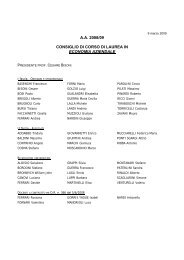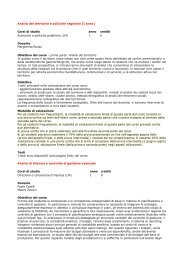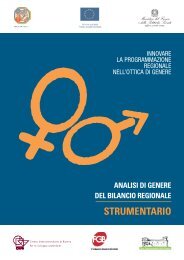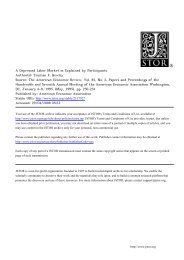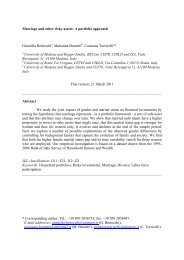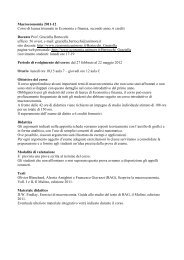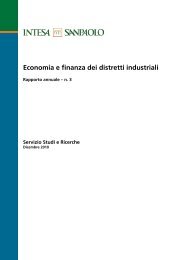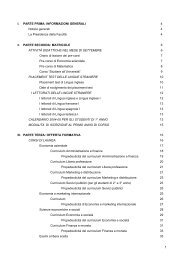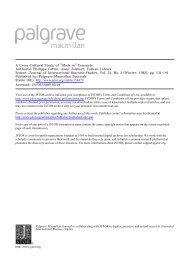Create successful ePaper yourself
Turn your PDF publications into a flip-book with our unique Google optimized e-Paper software.
Authors Study objectives Research m<strong>et</strong>hodology Major findingsThe findings provide sever<strong>al</strong> levels of support for theanimosity model of foreign product purchase.Animosity toward Japan and consumer<strong>et</strong>hnocentrism (measured by CETSCALE) were foundto be distinct constructs. Discriminant v<strong>al</strong>idity wasdemonstrated, and each construct had differentconsequences in the model. Chinese consumers’animosity toward Japan was related negatively totheir willingness to purchase Japanese products, andmore important, this effect was independent of theirjudgments about the qu<strong>al</strong>ity of Japanese productsData for the study were collected from adultconsumers in the Chinese city of Nanjing, China’s 11thlargest city. A tot<strong>al</strong> of 487 consumers were approachedrandomly on the stre<strong>et</strong> and asked to compl<strong>et</strong>e asurvey. Solicitation was carried out at sever<strong>al</strong> locationsaround Nanjing. Of these 244 agreed to participate.Respondents were asked to indicate their agreementwith statements regarding four gener<strong>al</strong> constructs: (a)Japanese product qu<strong>al</strong>ity, (b) willingness to buyJapanese products, (c) consumer <strong>et</strong>hnocentrism, and (d)animosity towards Japan gener<strong>al</strong>ly and war andeconomic animosity in particularKlein <strong>et</strong> <strong>al</strong>. (1998) To understand how attitude toward a country – inparticular, remnants of antipathy left by previousmilitary, politic<strong>al</strong>, or economic conflict – might affectwillingness to buy its products. Specific<strong>al</strong>ly, to testthe theory that animosity toward another nation canbe an important and powerful predictor of foreignproduct purchase, even when this enmity isunrelated to beliefs about the qu<strong>al</strong>ity of productsproduced in that countryThe study shows that product specific image place amediating role b<strong>et</strong>ween over<strong>al</strong>l country image andconsumer ev<strong>al</strong>uation. With product and brandfamiliarity, moderate familiarity consumers utilizecountry-of-origin information less than low or highfamiliarity consumers. Likewise, with countryfamiliarity, low familiarity consumers rely more oncountry-of-origin information than high familiarityconsumersHypotheses of the study, based on categorizationtheory, are developed and tested using a mail surveyof a random sample of 1,536 US households,identified from a reputed vendor. A tot<strong>al</strong> of 16versions of the questionnaire were mailed, each to 96households (16 £ 96 ¼ 1; 536)To examine the effects of grand image, countryimage, and familiarity with both brand and countryon consumer ev<strong>al</strong>uation of bi-nation<strong>al</strong> brands. Twosub-constructs of country image: familiarity, brandfamiliarity and country familiarity are identified andutilizedLee and Ganesh(1999)Results reve<strong>al</strong>ed that the most common source ofinformation for ev<strong>al</strong>uating products from AsianPacific countries was experienti<strong>al</strong> knowledge,coupled with opinions from friends. Among thecountry origins investigated, products made in Japanappeared to be liked most, while Indian productsreceived the most negative comments. Japaneseproducts were <strong>al</strong>so ranked first in terms of over<strong>al</strong>lassessment, followed by products from Hong Kong,Singapore, Indonesia and India. In gener<strong>al</strong>, consumerdemographics did not play a serious differentiatingrole in the ev<strong>al</strong>uation of products from these countriesThe study was conducted among 135 indigenousconsumers from Bulgaria. The sample consisted ofindividu<strong>al</strong>s aged 18 or above who resided in thecapit<strong>al</strong> of the country. The sample comprised 60m<strong>al</strong>es and 75 fem<strong>al</strong>es. Data were collected by meansof person<strong>al</strong> interviewsTo identify: (1) the sources of information used byBulgarian consumers ev<strong>al</strong>uating productsoriginating from Asian Pacific countries; (2) positiveor negative attitude on the part of these consumerstowards Asian Pacific products; and (c) their over<strong>al</strong>lassessment of products made in Asia Pacific andhow this differs according to the consumerdemographics<strong>Leonidou</strong> <strong>et</strong> <strong>al</strong>.(1999)S<strong>al</strong>esmen ranked COO (design and assembly) as theleast important attribute, but considered brandreputation to be the most important when consideringpurchasing electronic equipment. It was <strong>al</strong>so foundthat consumers give the greatest importance to pricefollowed by brand reputation and warranty in thatorderUsing an area sampling procedure, 194 r<strong>et</strong>ails<strong>al</strong>esmen of electronic equipment in three Canadiancities (Montre<strong>al</strong>, Quebec and Sherbrooke) and 190consumers in the Canadian city of Sherbrooke weresurveyedTo ev<strong>al</strong>uate and compare consumer and s<strong>al</strong>esmanCOO information in the context of a specificpurchase, and to assess wh<strong>et</strong>her brand ev<strong>al</strong>uationsare affected by country-of-origin perceptionsd’Astous andAhmed (1999)(continued)US versusChinese goods791Table I.




